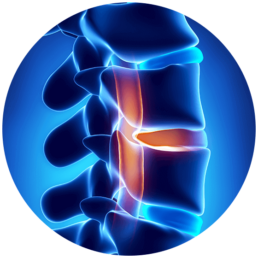Spinal Stenosis

Spinal Stenosis Symptoms & Treatment Options
Spinal stenosis is a general term that is used to describe a group of spinal conditions. These conditions involve a narrowing, or constricting, of the spinal column. This narrowing can lead to bone-on-bone contact, compression of the spinal nerves, or even compression of the spinal cord itself. Compression can lead to inflammation, pain, problematic mobility, and difficulty participating in one’s everyday activities.
There are many different locations on the spine, as well as several spinal structures, in which spinal stenosis can occur. Stenosis can appear in the cervical (neck), thoracic (rib cage), or lumbar (lower back) segments of the spine. However, a majority of cases are reported in the lumbar spine. In addition, different types of spinal stenosis are identified by the structure of the spinal column in which the narrowing occurs. These types include: central canal stenosis, foraminal stenosis, and far lateral stenosis.
Types of Spinal Stenosis
Central spinal stenosis is a narrowing of the central spinal canal through which the spinal cord runs. This constriction can lead to pressure on, as well as inflammation of, the spinal cord. Irritation or compression of spinal tissues often results in a variety of troubling symptoms.
Foraminal stenosis involves the narrowing of the foramina in the spine. The foramina are openings in the vertebrae that allow for nerve roots to branch outward from the spinal cord and to extend to far reaches of the body. When the foramina become smaller as a result of foraminal stenosis, spinal nerves often become compressed. This pinching of nerve tissue can lead to any of the painful, even debilitating, symptoms of spinal stenosis.
Far lateral stenosis involves narrowing near the facet joints. These joints, located on the back side of our vertebrae, connect one vertebra to another and help with the many movements of our spine. Our spinal nerves branch off from our spinal cord, pass through the foramina, and then travel on through the facet joints. When these joints become compromised by age, injury, or other factors, compression of nerves can occur and pain can ensue.
Address the following symptoms with the assistance of a medical professional:
An unnatural curve of the spine ranging from 10 degrees to 80 degrees or more
An abnormal gait, leading to possible joint damage in the hips, knees, or ankles
A pitched forward posture that makes it difficult to look ahead and ambulate
Pain and stiffness in the lower back or in the location of the degenerative curve
Tingling, loss of sensation, or stabbing pain because of pinched nerves and inflammation
Difficulty breathing as the exaggerated curvature of the spine compresses the lungs
Symptoms of Spinal Stenosis
As with many spinal conditions, the symptoms of spinal stenosis can seem very similar to other possible diagnoses. Additionally, symptoms can vary greatly from person to person, especially because stenosis can occur in different areas and structures of the spine. In order to accurately reach a diagnosis, it is important to consult a physician who can use all of the tools in their toolbox to fully assess the source of your pain and discomfort. That being said, if you experience any of the symptoms below, you may be dealing with spinal stenosis.
If you think you are experiencing any symptoms associated with spinal stenosis, please contact the Advanced Spine Center today. Dr. Jason E. Lowenstein is fully versed in minimally invasive treatments for spinal stenosis, and adopts an individualized, patient-centered approach to designing treatment plans. Dr. Lowenstein is here to help you find relief from your pain and discomfort, and will get you back to participating in your daily life
Causes of Spinal Stenosis
Just as there are many symptoms of spinal stenosis, there are nearly as many, if not more, causes of the condition. Most cases, however, occur due to age and degeneration of the spine over years of activity and use. We use our backs in practically all of our daily activities. Walking, lifting, twisting, sitting up, and laying down all put strain on our spine. Frequent use, coupled with the drying out of our spinal discs, can wear down the spine, causing spinal components to move closer together. Conditions associated with older age, such as osteoarthritis or rheumatoid arthritis, can also accelerate this degeneration as well.
Chronic strain on the back is another major cause of spinal stenosis. Although we all use our back every day, some individuals use it even more strenuously. Individuals who are especially at risk for developing spinal stenosis include those who work in labor intensive jobs such as nursing, construction, or athletics. These individuals place chronic strain on their spine, which can accelerate spinal degeneration and the development of stenosis.
Other causes of stenosis can include: spinal tumors, herniated discs, thickened ligaments, and overgrown bones (or bone spurs).